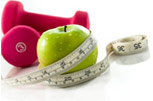Weight Loss Resources
Hundreds of articles about weight loss ...
Why use a Swiss Ball in training?
By Kelly Marshall BSc (Hons), Dip PT, NASM, SFS, IFS, CES
Discover the many benefits of this simple piece of equipment

The beginning
The origin of the swiss ball (also described as a 'fit ball'), dates back to 1963, where an Italian plastics manufacturer started production for use within physiotherapy treatment programs in Switzerland (hence the name 'Swiss' balls). Their use became increasingly featured in physcial therapy for treaing orthopedic and medical problems and in the last decade they have been massively incorporated into athletic training for all sports and as part of general fitness training for quality of life. It has also been intergrated into alternative forms of exercise like yoga and pilates and appears to have secured itself as a cornerstone within the health and fitness industry.

How it works?
Swiss ball training is classed under the category of 'functional stability training' - along with other balance tools such as Bosu Balls, stability discs, single leg training and power plates.
The whole concept of the Swiss ball is to create an unstable environment. In doing this, more demand is placed on the body as it tries to achieve stability, forcing it to use smaller stabilising muscles. In a nutshell, instability provides an increased challenge for the body, which results in increased benefits.
The Benefits
- With the body responding to the instability of the ball to remain balanced, it engages more muscles and individual muscle fibres. More muscle recruitment = more calories burned!
- Neuromuscular eficiency - the long term benefits of training your nervous system include delaying the age-related degeneration of our nervous system and reducing the risk of neuromuscular-related conditions like Parkinsons disease.
- Using a Swiss ball adds variation within your regular exercise plan, especially when you are an experienced / advanced exerciser who requires greater challenge to still achieve overload and progression.
- Swiss balls are effective as a regular tool for core training to optimsise your core stability and abdominal strength. Incoporating a balance demand takes the intensity and muscle activation of floor-based sit-ups to a new level!

- Psychological benefit - motivation is key to quality training! Effective improvements can be difficult to sustain for a variety of reasons such as lifestyle stress, boredom from the same routine, time pressures etc. Swiss ball training is consistently challenging and can serve as a real driving force to achieve mastery over the hundreds of different exercises avaliable.
- Swiss ball training is a phenomenal tool to have in your training tool box, so get a fitness professional to further your exercise knowledge and get more from how you train.
Disclaimer
You are advised to seek medical advice before beginning any exercise regime and/or weight loss programme. Nutracheck is only intended for use by healthy adult individuals and specifically not by under 18's, pregnant women, or individuals with any type of health condition. It is the responsibility of all users of this website to satisfy themselves as to their personal medical and physical condition in determining whether or not to use or adapt the information or content provided. Notwithstanding the medical or physical condition of a user, no responsibility or liability is accepted for any loss or damage suffered by an individual as a result of the use or misuse of any of the information or content in this website.
Disclaimer
You are advised to seek medical advice before making any changes to your diet or lifestyle with an aim of weight loss. This website and the content provided should not be used by persons under 18, by pregnant or nursing women, or individuals with any type of health condition, except under the direct supervision of a qualified medical professional. The information contained in these articles, and elsewhere on this website, is provided for educational and entertainment purposes only, and is not intended to replace, and does not constitute legal, professional, medical or healthcare advice or diagnosis and may not be used for such purposes. Continue...

